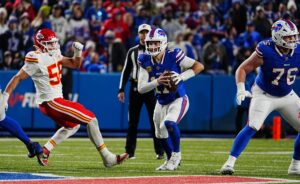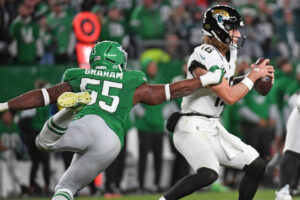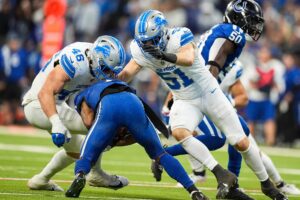Regression affects every position. The previous two articles focused on regression candidates for quarterbacks and running backs. And now the focus turns towards wide receivers.
As with the past articles, it’s important to note that the term “regression” doesn’t necessarily mean that the player will bust. Bust status is dependent on a player’s average draft position (ADP). ADP information is provided for most players so that you can draw your own conclusions. With that being said, “regression” here is defined as a player’s movement back towards the mean.
Here are the players who figure to move back to the mean in their receiving yards, yards per reception, targets, and/or touchdowns.
(All ADP information is from Fantasy Football Calculator. All statistical information is from Player Profiler and Pro Football Reference.)
Fantasy Football Wide Receivers: Who Will Regress in 2018?
DeAndre Hopkins & Will Fuller
ADP: 9.7 (standard), 8.2 (PPR) / 66.4 (standard), 67.8 (PPR)
Positional ADP: WR2 / WR27, WR29
Since DeShaun Watson is a regression candidate, it would make sense that his wide receivers would also take a hit. Although DeAndre Hopkins is the safest of the two options, he should see a dip in his target totals and his touchdowns.
The Houston Texans, as noted by Warren Sharp, have the easiest strength of schedule in 2018. Sharp’s strength of schedule also indicates that Las Vegas sportsbooks project the Texans to win 8.8 games. The ease of the schedule and the increase in wins would lead to more positive game scripts, which would lead to less passing attempts. In short, these changes will lead to fewer targets for Hopkins. It would also make repeating 13 receiving touchdowns more of a challenge.
Will Fuller will certainly face touchdown regression. How could he not? In a four-game stretch last year he had 13 receptions and seven touchdowns. Those four games also happened to be the only games that Fuller played with Watson. When the season finished, Fuller finished 14th in touchdowns (7), 84th in targets (50), 82nd in receptions (28), and 74th receiving yards (423) in ten games.
The good news for Fuller is that he is expected to have a bigger role in the offense this year. That could create an interesting situation where Fuller’s touchdown rate regresses, but his other counting stats demonstrate progression. His ADP indicates that early drafters are banking on that progression in 2018. Fuller does have obstacles to overcome. As mentioned before, the Texans will have more positive game scripts this year if the Las Vegas sportsbooks’ predictions come true.
Jarvis Landry
ADP: 63.8 (standard), 54.8 (PPR)
Positional ADP: WR26, WR24
Jarvis Landry is a regression candidate for two reasons: touchdowns and targets. Last season Landry scored nine touchdowns, which was easily his career high. He hit this mark despite not crossing the 1,000-yard mark for receiving yards. In short, repeating high touchdown totals is already hard enough, and that challenge becomes even harder with a low yard per reception average and a small stature (5’11”).
One of the things that pushed up Landry’s fantasy numbers last year (seventh best in 1/2 PPR) was his targets and target share. In 2017, Landry had 161 targets (third best) and a 27.4 percent target share (seventh best). Those numbers will be hard to repeat with the Cleveland Browns this year. Landry will have to compete with Josh Gordon, David Njoku, Duke Johnson, and Corey Coleman for targets. Add in the fact that the most passes Tyrod Taylor have thrown in a year is 436, and the amount of possible targets gets smaller and smaller. In short, Landry will have a hard time escaping regression this year.
Marvin Jones
ADP: 57.3 (standard), 57.4 (PPR)
Positional ADP: WR24, WR25
Marvin Jones finished as the ninth-best wide receiver last season in fantasy leagues (1/2 PPR). The fact that his current ADP doesn’t match that finish is good news. Now, Jones’ case for regression comes with rays of hope. For instance, his nine touchdowns in 2017 seem to be unrepeatable. However, over the past two years, Jones has averaged eight targets inside the 10-yard line, which is around the 22nd to 25th best in both seasons. He also saw the sixth most end zone targets (15) this past season.
There is a chance that trend changes this year though. Kenny Golladay is no longer a rookie, and Tim Twentyman reported that Golladay “looks really comfortable in year two.” Twentyman expects him to “be a big-time weapon in the red zone this season.” If this becomes true and Golladay sees the field more often, it would be bad news for Jones.
The other thing that stands out about Jones’ 2017 season is the efficiency. Jones had the 27th most receptions (61) and the ninth most receiving yards (1,101). In fact, Jones set a career high in yards per reception (18). Maintaining that kind of efficiency is difficult with a 57 percent catch rate. The good news for Jones and his fans is that he averaged 16.9 yards per reception in his first year with the Detroit Lions. In other words, while his yards per reception average should regress this year, it won’t plummet if he maintains the same role with the Lions.
Overall, if you’re drafting Jones because you’re expecting to see top ten fantasy numbers, he will disappoint you. Remember that his 2016 fantasy numbers (42nd amongst wide receivers) showed that his floor is much lower than that.
Robby Anderson
ADP: 113 (standard), 98.2 (PPR)
Positional ADP: WR44, WR41
Robby Anderson‘s legal troubles have almost certainly affected his ADP in early drafts. Well, that or people understand that Anderson has little to no shot at repeating his numbers from last year for two important reasons. First, Quincy Enunwa is healthy and playing this year, which will eat into the 23 percent target share that Anderson saw last year. Second, touchdowns from year to year are fluky. Anderson brought in a career-high of seven scores last year (14th best amongst wide receivers). As if trying to repeat that number wasn’t hard enough, now he has to compete with the aforementioned Enunwa, Jermaine Kearse, and the recently signed Terrelle Pryor for targets and scoring chances. To sum it all up, if Anderson is losing targets and scoring chances, how will he repeat those numbers with a 55.3% catch rate? The answer is simple: he won’t.
Honorable Mention
Alshon Jeffery
Alshon Jeffery is an interesting case. On one hand, if he continues this trend of low reception totals, it would be hard for him to repeat his touchdown totals. Especially since Carson Wentz‘s touchdown percentage should also regress. On the other hand, Jeffery was in the top 10 in air yards (airyards.com), which could indicate a rise in receiving yards in the future.






